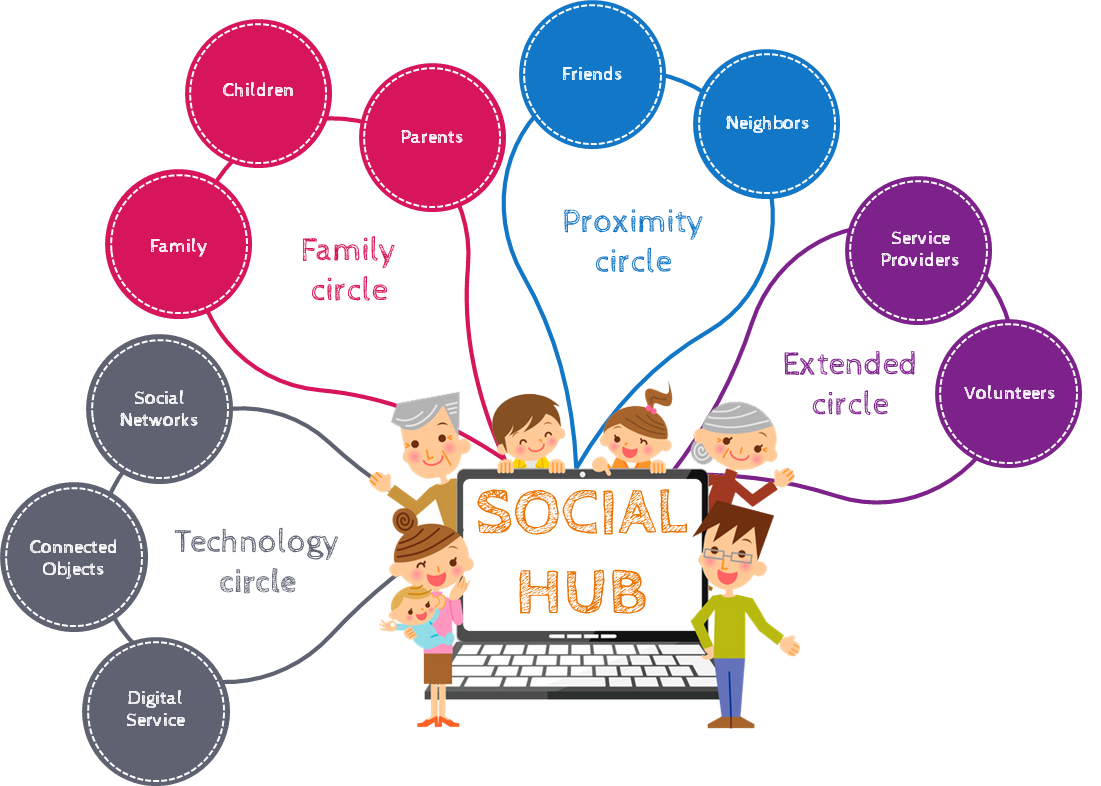More and more people of all ages use social networks. The need of social link between family and friends is an essential aspect during the whole life. Today, new kind of partners appear: smart objects. But do they really have a place in our social networks?
At Hakisa, we believe they do. The integration of connected objects is one of the major differences between a social network and a social hub.
What is a social hub?
A social hub has three main objectives:
- to promote social link, essential for a good quality of life
- to bring services on demand adapted to each person’s needs and desires
- to give new technologies a human dimension by making them useful and usable in order to facilitate their adoption
Nowadays, we can say that our everyday life consists of four circles.
Those four circles surrounding a person are all connected in the social hub:
- the family circle, which is essential for seniors
- the proximity circle, which is essential for young people
- the extended circle, which depends on individual needs
- the technology circle, which integrates new connected objects
From social network to social hub
Even if social networks offer a great range of features, their use still depends on the age of the users and the media which is implemented (texts, photos, videos). Therefore many different solutions exist, each adapted to a different use and a different age group.
However, today the social hub adds a vital dimension: the integration of connected objects as active members of a social network.
Within a social hub, connected objects gain a social dimension because they communicate with their owners and the community that is interested in the transmitted data.
For example, a fall detection system for an elderly person triggers an alarm (event) which will be passed on to his children, his neighbors or to a professional monitoring center (community of interest). Another example is a blood pressure detector alarming the treating doctor and the family of the patient.
In both cases, a conversation between humans concerning this special event will be triggered in order to receive the alarm, take care of it and inform the community of interest about the next possible steps.
Human interaction in the heart of the social hub
In the sector of e-health and home automation, in a broader sense (Ambient Assisted Living), it is the human action that offers the real service to the user. The fact that technology can work without any human interaction of course is impressive, but is it really useful?
In many cases, the service and the expertise linked to those new technologies turn them into useful and sustainable objects. Otherwise, connected objects might only be considered as gadgets and will be put aside after a few weeks of use.
At Hakisa, we believe that implementing a social process allowing all the passive detectors to send an alarm in case of danger or irregular events then establishing a natural dialogue between human and object is crucial.
This way, members (defined and authorized) of a community of interest that are connected to the detector can consult the information given by the detector concerning its use.
Can the technology tell me the temperature in my grandmother’s apartment? Or if she has left her place this morning? Even if this information is already integrated in the management interface of connected objects, it still lacks the social aspect and the ability to share the information within communities.
That is why Hakisa’s ambition is to humanize those technologies and to integrate them into real communities in order to focus their use on the person.


4 thoughts on “From social network to social hub”